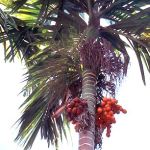| Common Name: |
Betel Nut Palm |
| Other Names: |
Areca palm, pinang |
| Botanical Name: |
Areca catechu |
| Genus: |
Areca |
| Family: |
Arecaceae |
| Cultivation: |
Moist, well-drained soil in sun, with high humidity. |
| Propagation: |
By seed sown in spring at 24-27°C (75-81°F) |
| Harvest: |
Fruits are collected when ripe and dried for use in decoctions and liquid extracts, or as a powder. |
| Native Location: |
SE Asia |
| Height: |
20m (70ft) |
| Width: |
4m (12ft) |
Hardiness: |
Min. 16°C (61°F) |
| Parts Used: |
Fruit rind (da fu pi), seeds (bing lang) |
| Properties: |
An astringent, stimulant herb that relieves hunger, abdominal discomfort, and weariness. Kills intestinal parasites and other pathogens and has diuretic and laxative effects. |
| Medicinal Uses: |
Mainly in veterinary medicine to expel tapeworms. Internally, in traditional Chinese medicine, to destroy intestinal parasites, and for dysentery and malaria (seeds); as a laxative in constipation with flatulence and bloating, and as a diuretic in edema (rind). Excess causes profuse salivation, vomiting and stupor.
Areca nut is chewed for its intoxicating qualities but is also used to treat edema, diarrhea, digestive problems, schizophrenia, glaucoma, and chronic hepatitis. |
| Warning: |
This herb is subject to legal restrictions in some countries. |
| Typical Dosage: |
There is no typical dose of areca nut, although eleven nuts per day is common among frequent users. |
| Possible Side Effects: |
Areca nut's side effects include tremors; slowed heart rate; staining of the mouth, lips, and feces; euphoria; and increased salivation. Long-term use can result in cancer of the oral cavity. Taking 8 to 10gm may be toxic to humans. |
| Drug Interactions: |
| Taking areca nut with these drugs may enhance the therapeutic and adverse effects of the drugs: |
| Acetylcholine, (Miochol-E) |
Bethanechol, (Duvoid, Urecholine) |
Carbachol, (Carbastat, Isopto Carbachol) |
Cevimeline, (Evoxac) |
| Donepezil, (Aricept) |
Edrophonium, (Enlon, Reversol) |
Galantamine, (Razadyne) |
Methacholine, (Provocholine) |
| Neostigmine, (Prostigmin) |
Physostigmine, (Eserine) |
Pilocarpine, (Isopto Carpine, Salagen) |
Pyridostigmine, (Mestinon) |
| Rivastigmine, (Exelon) |
Tacrine, (Cognex) |
| Taking areca nut with these drugs may interfere with the actions of the drug: |
| Atropine, (Isopto Atropine, Sal-Tropine) |
Benztropine, (Apo-Benztropine, Cogentin) |
Clidinium and Chlordiazepoxide, (Apo-Chlorax, Librax) |
Cyclopentolate, (Cyclogyl, Cylate) |
| Dicyclomine, (Bentyl, Lomine) |
Glycopyrrolate, (Robinul, Robinul Forte) |
Homatropine, (Isopto Homatropine) |
Hysoscyamine, (Hyosine, Levsin) |
| Hyoscyamine, Atropine, Scopolamine, and Phenobarbital, (Donnatal, Donnatal Extentabs) |
Ipratropium, (Atrovent, Nu-Ipratropium) |
Oxitropium, (Oxivent, Tersigat) |
Prifinium, (Padrin, Riabel) |
| Procyclidine, (Kemadrin, Procyclid) |
Propantheline, (Propanthel) |
Scopolamine, (Scopace, Transderm Scop) |
Tiotropium, (Spiriva) |
| Tolterodine, (Detrol, Detrol LA) |
Trihexyphenidyl, (Artane) |
Trimethobenzamide, (Tigan) |
|
| Lab Test Effects: |
May interfere with fecal lab tests since chewing areca nuts stains the feces red. |
| Disease Interaction: |
May worsen asthma. |
| Bibliography: |
Encyclopedia of Herbs by Deni Brown. Copyright © 1995, 2001 Dorling Kindersley Limited. pp 127-128
The Essential Herb-Drug-Vitamin Interaction Guide by Geo. T. Grossberg,MD and Barry Fox,PhD Copyright©2007 Barry Fox,PhD pp. 44-45
|

